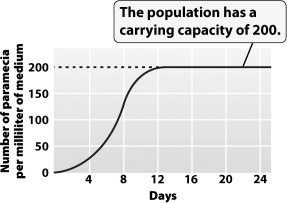Correct Answer

verified
Correct Answer
verified
Multiple Choice
When an isolated population reaches its carrying capacity
A) the birth rate > the death rate.
B) the birth rate = the death rate.
C) the birth rate < the death rate.
D) It is not possible to generalize these values.
Correct Answer

verified
Correct Answer
verified
Multiple Choice
A population of 100 individuals is undergoing exponential growth, with a constant growth rate of 0.2 per year. What size will this population be in 2 years?
A) 100
B) 120
C) 144
D) 200
Correct Answer

verified
Correct Answer
verified
True/False
Humans are the only species not subject to limits on the size of its population.
Correct Answer

verified
Correct Answer
verified
Multiple Choice
The carrying capacity of owls in an Alaskan forest is 8 per square kilometer. What will happen if 12 owls are confined to a 1-square-kilometer area?
A) The owls will survive together and develop ways to share resources.
B) The owls might survive as malnourished adults but the next generation will have no more than eight individuals.
C) The population of owl prey organisms will increase proportionately.
D) A short-term exponential growth of owls will occur.
Correct Answer

verified
Correct Answer
verified
Multiple Choice
Which of the following has the smallest contribution to annual changes in the size of a population?
A) weather
B) predators
C) climate
D) disease
Correct Answer

verified
Correct Answer
verified
Short Answer
If we humans do not limit our population growth rate, we will exceed the ____________________ of our environment, leading to a larger population than the environment can support.
Correct Answer

verified
Correct Answer
verified
Multiple Choice
A population is counted at 100 individuals in 1998. In 2006, a new count found 1,600 individuals. What is the doubling time for the population?
A) 0.5 year
B) 1 year
C) 1.5 years
D) 2 years
Correct Answer

verified
Correct Answer
verified
Short Answer
Use of the environment that can continue indefinitely without depleting all our resources or causing environmental damage is defined as being ____________________.
Correct Answer

verified
Correct Answer
verified
Multiple Choice
The change in size of a given population of organisms may have a direct impact on humans. The 1993 outbreak of hantavirus in the southwestern United States was partly due to a(n)
A) tightly linked cycle of human and hantavirus populations.
B) increase in the deer mouse population size.
C) decline in the desert salamander population, the normal hantavirus host.
D) increase in human population size.
Correct Answer

verified
Correct Answer
verified
True/False
Exponential growth curves are always J-shaped.
Correct Answer

verified
Correct Answer
verified
Multiple Choice
The top of the "S"in an S-shaped curve indicates that the population
A) is on the verge of collapse.
B) is experiencing abnormally heavy pressure from predators.
C) has reached its carrying capacity.
D) is poised for further exponential growth.
Correct Answer

verified
Correct Answer
verified
Multiple Choice
The maximum population size that can be supported by its habitat is known as
A) maximum increase.
B) carrying capacity.
C) exponential growth.
D) population balance.
Correct Answer

verified
Correct Answer
verified
Multiple Choice
The population explosion that occurred shortly after the Opuntia cactus was introduced to Australia is an example of
A) exponential growth.
B) emigration.
C) reduced population density.
D) a native species outcompeting an introduced species.
Correct Answer

verified
Correct Answer
verified
Multiple Choice
The term population density describes the
A) body size of different species.
B) number of individuals per unit area.
C) number of populations per unit area.
D) number of species per unit area.
Correct Answer

verified
Correct Answer
verified
Short Answer
Overall, when there are more individuals in a population, birth rates ____________________.
Correct Answer

verified
Correct Answer
verified
Short Answer
China's ____________________ policy has slowed the growth of the population in that country to 0.57 percent currently from 1.07 percent during the 1990s.
Correct Answer

verified
Correct Answer
verified
Multiple Choice
Which of the following situations illustrates a link between the effects of density-dependent and density-independent factors?
A) A flood causes a river to overflow and drown a herd of deer.
B) A drought occurs; a small herd of deer is able to survive, whereas a larger herd in the same area perishes.
C) A population of deer increases to a size at which individuals are competing with each other to get enough food.
D) None of the above are correct because density-dependent and density-independent factors cannot affect the same population of organisms at the same time.
Correct Answer

verified
Correct Answer
verified
Multiple Choice
The graph below shows the growth of a Paramecium population.  The greatest amount of daily growth occurred when the population was at approximately _____ percent of its carrying capacity
The greatest amount of daily growth occurred when the population was at approximately _____ percent of its carrying capacity
A) 10
B) 25
C) 50
D) 100
Correct Answer

verified
Correct Answer
verified
Multiple Choice
The size of a population can be decreased by
A) a higher birth rate.
B) immigration.
C) emigration.
D) a reduced death rate.
Correct Answer

verified
Correct Answer
verified
Showing 21 - 40 of 69
Related Exams